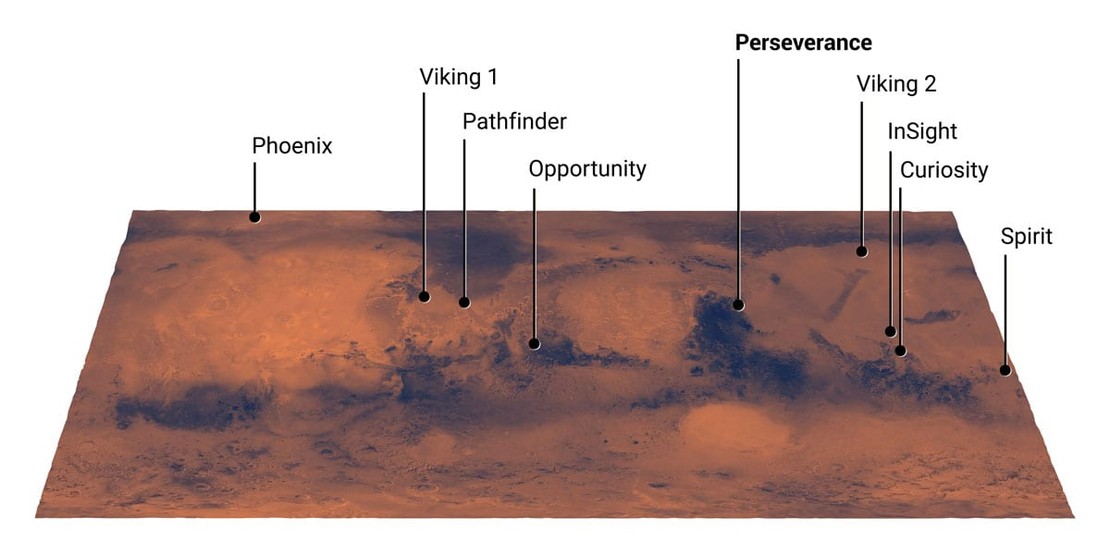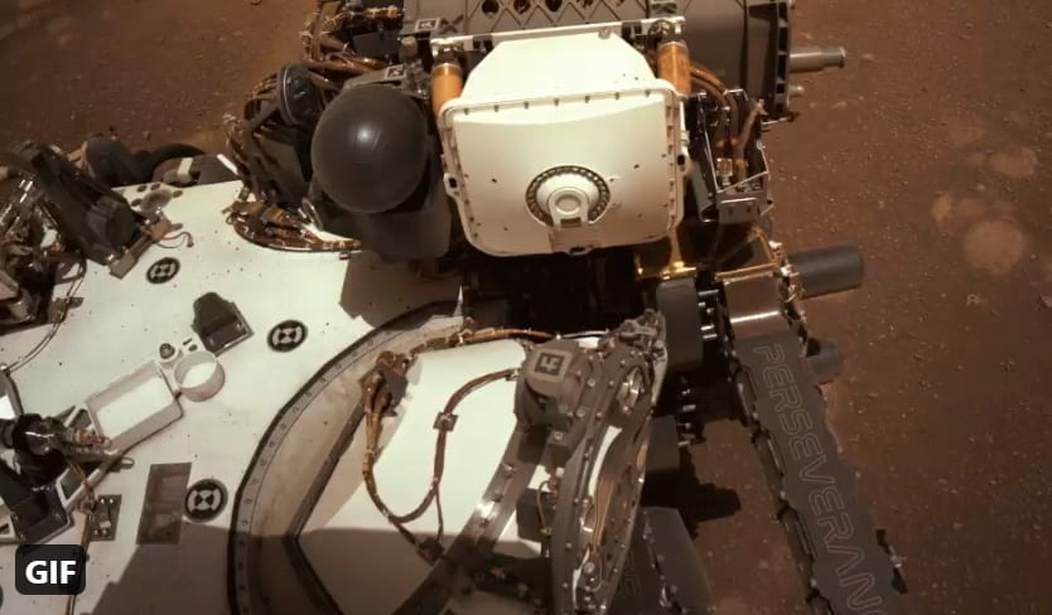Mars rover and drone flier Perseverance landed successfully on the red planet in February after a journey of several months and nearly 300 million miles. The rover will spend its mission, slated for about two Earth years, in the Jezero Crater with the explicit goal of searching for signs of life. If you’re a space nerd like me, this mission promises to be a feast.
Jezero Crater tells a story of the on-again, off-again nature of the wet past of Mars. More than 3.5 billion years ago, river channels spilled over the crater wall and created a lake. Scientists see evidence that water carried clay minerals from the surrounding area into the crater lake. Conceivably, microbial life could have lived in Jezero during one or more of these wet times. If so, signs of their remains might be found in lakebed or shoreline sediments. Scientists will study how the region formed and evolved, seek signs of past life, and collect samples of Mars rock and soil that might preserve these signs.

Today Perseverance deployed its wind sensor.
The wind sensor is part of Perseverance’s weather station, which is called the Mars Environmental Dynamics Analyzer (MEDA). The instrument will monitor air temperature, humidity, radiation, dust and wind at Perseverance’s landing site, the floor of Jezero Crater, a 28-mile-wide (45 kilometers) hole in the ground that harbored a deep lake and a river delta in the ancient past.
This week I’ve been doing lots of health checkouts, getting ready to get to work. I’ve checked many tasks off my list, including instrument tests, imaging, and getting my arm moving. Warming up for a marathon of science. pic.twitter.com/A0aqhWVo5T
— NASA's Perseverance Mars Rover (@NASAPersevere) March 3, 2021
The weather station will help Perseverance find and use something humans have never had on Mars before: a working airfield. You have to know weather conditions to successfully and safely launch and land the rover’s drone copter. That copter, called Ingenuity, weighs about four pounds and cost $80 million. So it’s not your recreational drone by a long shot. It’s built to do science and make history.
“This is really a Wright brothers moment, but on another planet,” says MiMi Aung, the Ingenuity project manager at NASA’s Jet Propulsion Laboratory in California. She and her colleagues repeat that mantra at every opportunity.
Ingenuity may be able to fly as often as five times every 30 days. It and all of the rover’s other systems will require electrical power to perform their tasks and hunt for evidence of past or present life on Mars. Ingenuity checked in with its control team shortly after the rover landed.
“There are two big-ticket items we are looking for, the state of charge of Ingenuity’s batteries as well as the confirmation the base station is operating as designed, commanding heaters to turn off and on to keep the helicopter’s electronics within an expected range,” Tim Canham, Ingenuity Mars Helicopter operations lead at JPL said in a statement. “Both appear to be working great. With this positive report, we will move forward with tomorrow’s charge of the helicopter’s batteries,” Canham added.
Keeping the rover and its first-ever drone copter alive requires something we’re familiar with here on our home planet: rechargeable lithium batteries. Our cell phones, tablets, and electric cars tend to use lithium batteries.
I remember years ago, in the early days of the development of the soon-to-be-launched James Webb Space Telescope, meeting with some of that mission’s top scientists. I was a producer for Hubble at the time, and our team was handling some of the early communications for the JWST. During a meeting one of the lead scientists at the time lamented how difficult it was to find American manufacturers and suppliers for the massive telescope’s numerous components. “We just don’t make anything anymore.” The comment stuck with me.
Most NASA work is done by contractors — I was actually a Honeywell (HON) employee most of the time I worked at Space Telescope. On Mars, Perseverance must rely on solar power and its lithium batteries. Those batteries, it turns out, are protected by technology developed by a San Diego company called KULR (KULR). In a recent interview, KULR CEO Michael Mo described the “seven minutes of horror” of Perseverance’s controlled, very complex, and risky landing on Mars.
Lithium batteries sometimes make news for the wrong reasons: a tendency to catch on fire. For a mission to Mars, which cost over $2.4 billion and is far beyond the reach of astronauts for repairs such as those performed on the Hubble over the years, this would be catastrophic.
It could happen; Mars’ atmosphere is thin but not non-existent.
“We make a carbon fiber heat sink, that’s part of the SHERLOC instrument on the Mars rover,” Mo explained. “We keep the laser and the sensors on that instrument in good operating condition. On Mars you have very hot as well as very cold temperatures. So those sensitive instruments need to be kept in a very nice ambient environment to operate so they can look for signs of life.”
SHERLOC is one of a pair of instruments — the other appropriately called WATSON — that will lead the life-hunt.
SHERLOC, an instrument on the end of the rover’s robotic arm, will hunt for sand-grain-sized clues in Martian rocks while working in tandem with WATSON, a camera that will take close-up pictures of rock textures. Together, they will study rock surfaces, mapping out the presence of certain minerals and organic molecules, which are the carbon-based building blocks of life on Earth.
SHERLOC was built at NASA’s Jet Propulsion Laboratory in Southern California, which leads the Perseverance mission; WATSON was built at Malin Space Science Systems in San Diego.
The laser Mo mentioned will help scientists determine the composition of the rocks the rover studies and understand how they formed. KULR’s heat sinks, which were built in San Diego, protect SHERLOC’s batteries from the extreme temperatures on Mars. Similar tech also protects astronauts’ laptops on the International Space Station and the lithium batteries in electric vehicles here at home. Improvements made to power Perseverance will help improve battery tech for civilian uses.
Perseverance is just getting started. Today’s deployment of the wind sensor will lead to its aerial operations, while SHERLOC and WATSON get ready for the life hunt (and WATSON will also handle taking Perseverance’s selfie shots). We’re in for some amazing imagery and history-making science from the Jezero Crater. The batteries aboard Perseverance can last up to 14 years, so we could seeing and hearing from the surface of Mars far longer than its advertised lifetime. The rovers Spirit and Opportunity both outlasted their expected 90-day lifetimes by many years. Their batteries just kept chugging along.
Bryan Preston was the producer for NASA’s Hubble Space Telescope and is the author of Hubble’s Revelations: The Amazing Time Machine and Its Most Important Discoveries. He’s a writer, producer, veteran, author, and Texan.
Biden Promises Science Will Guide Him. So Why Is He Canceling the Keystone XL Pipeline?









Join the conversation as a VIP Member